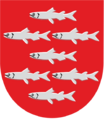Coregonus albula facts for kids
Quick facts for kids Coregonus albula |
|
|---|---|
 |
|
| Conservation status | |
| Scientific classification |
The vendace or European cisco (scientific name: Coregonus albula) is a type of freshwater whitefish. It belongs to the Salmonidae family, which also includes salmon and trout.
You can find vendace in lakes across northern Europe. This includes countries like Finland, Latvia, Lithuania, Sweden, Russia, and Estonia. They also live in some lakes in Norway, the United Kingdom, northern Germany, and Poland. Sometimes, they are found in slightly salty water in the Gulfs of Finland and Bothnia, which are part of the Baltic Sea.
An adult vendace is usually about 20 cm (8 in) long. They can live for about ten years.
Vendace have traditionally been very important for fishing in parts of northern Europe and Russia. Their roe (eggs) are considered a special food. In Sweden, the roe from the Bothnian Bay is even protected as a special regional product called Kalix löjrom.
Contents
What Does a Vendace Look Like?
The vendace is a slim fish with a smooth body shape. It has a special small fin on its back, between its main back fin and its tail. This fin is called an adipose fin, and it's common in the salmon family.
One way to identify a vendace is by its jaws. Its lower jaw is longer than its upper jaw. This helps tell it apart from similar fish. For example, the common whitefish has an upper jaw that is longer than its lower one. The peled has jaws that are about the same length.
The back of a vendace is usually bluish-green or brown. Its sides are shiny and silver, and its belly is white. This fish rarely grows longer than 30 cm (12 in).
How Do Vendace Live?
Vendace mainly eat tiny creatures that float in the water, like small crustaceans and their babies. Bigger vendace might also eat insects that fall on the water or even very small fish fry.
These fish live in large groups called schools. When it's time to lay eggs, they choose pebbly or sandy areas. Some lay eggs in shallow water, while others go deeper, up to 20 m (66 ft) down. Vendace grow up quickly. Most of them will lay eggs for the first time when they are about two years old. Some might even breed in their first autumn.
Different Kinds of Vendace
The European vendace is very closely related to a fish from Siberia called the Coregonus sardinella (sardine cisco). It's also related to C. peled, even though they look different.
Scientists have found that there are different types of vendace. Sometimes these differences are based on where they live. Other times, different types of vendace can live in the same lake.
For example, in the United Kingdom, some scientists consider the vendace populations there to be a separate species, Coregonus vandesius. However, not all scientists agree with this idea.
Most vendace lay their eggs in the autumn. But in some lakes in northern Europe, there are special populations of vendace that lay their eggs in the spring! Some of these spring-spawning vendace have even been described as separate species. For instance, in Sweden, there's Coregonus trybomi. In two lakes in northern Germany, there are Coregonus fontanae and Coregonus lucinensis. These spring-spawning fish live in the same lakes as the autumn-spawning vendace. It seems they developed these different breeding habits on their own in each lake after the last ice age.
See also
Images for kids
-
Seven vendaces in the coat of arms of Viitasaari





